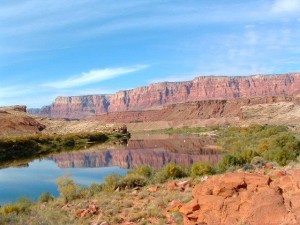The folks at the University of Colorado’s Colorado River Governance Initiative have a clever idea to keep the Upper Basin states from getting screwed by climate change. Their new Upper Basin Voluntary Demand Cap white paper (pdf) offers a solution path for one of the stickiest problems in future Colorado Basin water management under climate change.
In short, it’s a bargain under which the two basins would share a huge risk at the intersection of climate change and legal uncertainty over interpreting the Law of the River.
The sticky problem is Article III(d) of the 1922 Colorado River Compact (pdf):
The States of the Upper Division will not cause the flow of the river at Lee Ferry to be depleted below an aggregate of 75,000,000 acre-feet for any period of ten consecutive years reckoned in continuing progressive series beginning with the first day of October next succeeding the ratification of this compact.
Translated, that means the Upper Basin states might have to deliver 7.5 million acre feet of water each year at Lee’s Ferry. With a river twice that size, the compact’s authors presumed, there would be plenty of water for the upper basin states (New Mexico, Colorado, Utah and Wyoming) to use their half and just pass the rest of the water on down for California, Nevada and Arizona. But there’s a central unresolved legal question, as the CRGI folks wrote in a white paper last year (pdf):
[T]he prevailing interpretation has been that the Upper Basin has the obligation to deliver 75 million-acre feet every ten years (an average of 7.5 million acre-feet/year) downstream to the Lower Basin, and if this leaves insufficient water for the Upper Basin to consume the 7.5 million acre-feet promised in Article III(a), then the Upper Basin must bear that shortage in its entirety. However, a counter interpretation more favorable to the Upper Basin is that they do not have a delivery obligation, but rather an “obligation not to deplete” the flow of the river below an average of 7.5 million acre-feet/year based on the language used in Article III(d) of the Compact.
Not surprisingly, you can pretty much guess the legal interpretation a lawyer will offer based on which basin they’re from. Lower Basin attorneys say, “Yup, gotta deliver 7.5, no matter what.” Upper Basin attorneys say, “No, if the river’s low because of a changing climate, rather than our depletions, we’re off the hook.”
This disagreement is a huge deal because under the former interpretation, if as expected climate change reduces the flow in the river, the Upper Basin takes the entire squeeze.
The thing is, water managers hate uncertainty. And no one’s lawyers, Upper or Lower Basin, can guarantee which way a judge would rule if they threw the dice and went to court. The downside risk is enormous.
The CRGI folks call their idea the “Upper Basin Voluntary Demand Cap.” The idea is that Upper Basin states agree to cap their total depletions at some level below the 7.5 million acre feet allotted to them under the compact (which they’re not using right now anyway). In return for holding their consumption line there, the Lower Basin agrees not to make a “compact call” if deliveries at Lee’s Ferry drop below 7.5 maf:
Establishing the value of the “cap” and the release objective are points to be negotiated; but the principle is to establish these numbers in advance of a crisis and without a need to litigate the omissions and ambiguities that exist in the Compact and related elements of the Law of the River.
There’s precedent for this sort of approach in the 2007 shortage sharing agreement, which doesn’t supplant the Law of the River but is rather, in the words of the CRGI folks, “an operational regime placed on top of this foundation.”
It’s the kind of solution space I was thinking of in my “What Seven States Can Agree To Do” piece last year, though I’m not smart enough to come up with the specifics. The Law of the River is malleable if all the parties can come to agreement on the bends it needs.


Doesn’t the upper basin deplete the flow by diverting in making consumptive use of the water? Even if this alternate reading is correct, to have effect wouldn’t the natural flow of the River need to drop below 7.4 MAF year?
Pingback: Another Week of GW News, July 7, 2013 – A Few Things Ill Considered
Pingback: Blog round-up: Bloggers on the BDCP, relaxing water quality standards, eliminating the ESA, plus the Mono Lake Committee takes action and the Salton Sea gets a blow … and more » MAVEN'S NOTEBOOK | MAVEN'S NOTEBOOK
Pingback: Blog round-up: Bloggers on the BDCP, relaxing water quality standards, eliminating the ESA, plus the Mono Lake Committee takes action and the Salton Sea gets a blow … and more » MAVEN'S NOTEBOOK | MAVEN'S NOTEBOOK